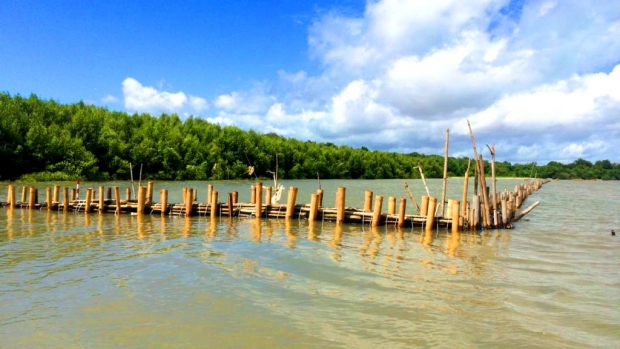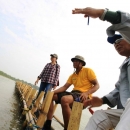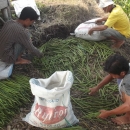Grants :: Small Grant Facilities :: The Application of Mud Trap Technique as the Medium of Coastal Rehabilitation in Pulau Dua, Nature Reserve
The Application of Mud Trap Technique as the Medium of Coastal Rehabilitation in Pulau Dua, Nature Reserve

The semipermeable structures as sediment trap, Sawah Luhur village, Serang-Banten, West Java © Setyawati/MFF-Indonesia, 2016
Objectives
The project objective is to protect coastal area in the buffer zone of Pulau Dua Nature Reserve through the application of mud trap to create natural habitat for mangroves, and improved communities livelihood.
Background
In the last ten years, coastal ecosystem in Pulau Dua Nature Reserve, Sawah Luhur Village Serang Banten has suffered from environmental problems. Triggered by population growth and economic development, mangrove forests surrounding this area were massively converted into settlements and ponds for aquaculture. It all caused the lost of wildlife habitat and foraging territory for wetlands animals, increased illegal bird hunting and lost of livelihood sources. Mangrove conversion has also contributed to carbon emission and climate change. Not only this, due to the lost of mangrove forest, Pulau Dua Nature Reserve has been exposed to pubic and highly gets pressure from visitors who visited the area.
The Nature Lovers Group, consist of local community members, which is known as Kelompok Pecinta Alam Pesisir Pulau Dua (KPAPPD), has been implementing mangrove rehabilitation in the buffer zone of Pulau Dua Nature Reserve and its surrounding since 2013. The rehabilitation activity has been engaging local government for policy support and involving NGO (Wetlands International Indonesia) for technical support. Mangrove seedlings were planted along the coastal area in the buffer zone and in barren aquaculture's ponds. Communities have applied a small scale sediment trap to protect mangrove seedling from sea current. After three years, mangrove seedlings were growing with the high survival rate, created new mangrove green belt of Pulau Dua Nature Reserve. It has positive impact to improve coastal resilience towards natural disaster and to mitigate climate change. New mangrove forest have significantly reduced coastal abrasion and restore natural habitat for fish and other wetlands animals. This condition also benefits local fishers as they do not have to go fishing further offshore. Other benefits include inland settlement in Sawah Luhur Village is protected from sea water intrusion, and people get cultural service such as recreational facilities.
Through Small Grant Facility (SGF) project, KPAPPD continued applying rehabilitation technique using mud trap (made from bamboo and sandbags) in total length of 300 m,and mangrove seedlings were planted in the newly formed sedimentation area. In terms of empowerment program, the project engaged women group to generate family income by producing fisheries-based food products.
Target beneficiaries
Two community members were formed during the project implementation consisting of 23 members (48% females and 52% males). In total, direct beneficiaries of this project were 99 people and indirect beneficiaries were approximately 8,697 people (48% females and 52% males).
Outputs
April 2016, KPAPPD along with communities had built 120 m long semipermeable structures as sediment trap made from bamboo and sandbags. After two months, the sediment trapped was up to 30 cm high, where could be seen during the low tide. At the end of project period, the overall semipermeable structures built were 300 m long.
1,000 mangrove seedlings were grown in nursery. In addition, communities also prepared 12,000 mangrove seedlings as in-kind contribution.
Besides promoting an approach to create the suitable site for mangroves to grow back naturally, KPAPPD also planted 10,000 mangrove seedlings in a newly formed sedimentation area, and 8,500 of them grew well.
Community groups received training on breakwater construction. The training had improved knowledge and skills of group members in maintaining mud trap construction. In addition, a women's group was empowered to generate additional family income. They received training on fisheries-based food production and it improved their knowledge and skills in making fish stick and fish cracker from milk fish. Additional income generated from the livelihood activities was approximately more than IDR 1 million per month, and it was used to fulfill basic needs.
Accomplishments and challenges
 |
Contributions to cross-cutting themes
Climate Change
This project was designed to restore and preserve mangrove ecosystem. Rehabilitation efforts were carried out in the framework of the reduction of Green House Gas (GHG) emissions through mangrove planting. The newly sedimentation area and mangrove seedlings planted will sequester carbon that helps to tackle climate change.
Gender Equality
Gender is also considered in this project. Among 30 participants involved in preparing mangrove nursery, 10 are women. Moreover, in the capacity building program community members involved were 100% women.
Lessons Learned
- Besides planting mangrove as a way to rehabilitate degraded mangrove areas, there is another approach recently introduced, i.e. a method to create the suitable site for mangroves to grow back naturally. Mangroves restored in this way generally survive and function better.The application of mud trap technique is one of the innovative methods that will create the proper conditions for mangroves to grow back naturally.
- The initiation of small scale businesses, training and followed by the production itself might take some time (going through some trials and errors). It is sometimes hard to estimate percentage of the benefit per month from the activities that instant, and the project period is also relatively short (10-12 months). The most reasonable outputs than can be expected from these activities are knowledge sharing to the direct beneficiaries (groups involved) on how to process fish and other products to become commodities with more economic value and to build entrepreneurial spirit.
- While choosing the types of livelihood activities to be conducted, it is best to use participatory approach, where grantee has gone through consultation process with the communities as the implementer on the ground. In addition, it is important to identify the all supporting aspects related to the livelihood activities/small-scale business starting from the provision of the raw materials, production, marketing to the management of the profit generated and cash flow to ensure the sustainability of the business.
Project Facts
Country
Location
Coastal area in Pulau Dua Nature Reserve, Sawah Luhur Village, Serang-Banten
Topic
Duration
2nd Mar 2016 to 31st Dec 2016
MFF Grant Amount
IDR 170,000,000
Co-financing Partner
In kind from others IDR 27,000,000 (USD 2,213)
In kind from Grantee IDR 14,750,000 (USD 1,209)
Implementing Partner
Kelompok Pencinta Alam Pesisir Pulau Dua (KPAPPD) - Local Group
Sawah Luhur Village, Kasemen Sub-District, Serang District-Banten, West Java

